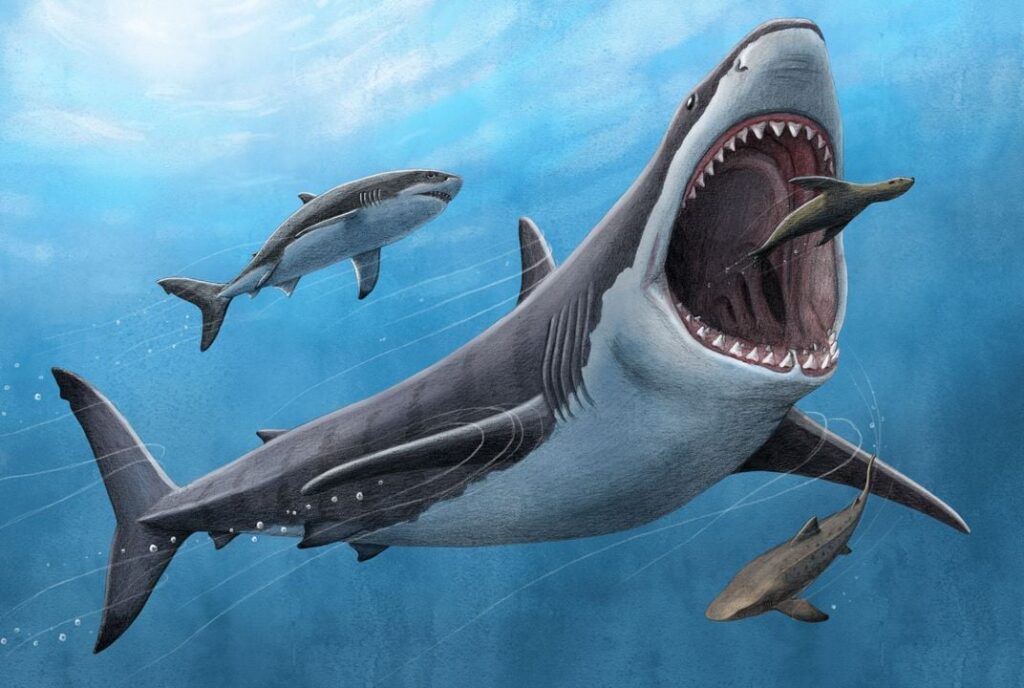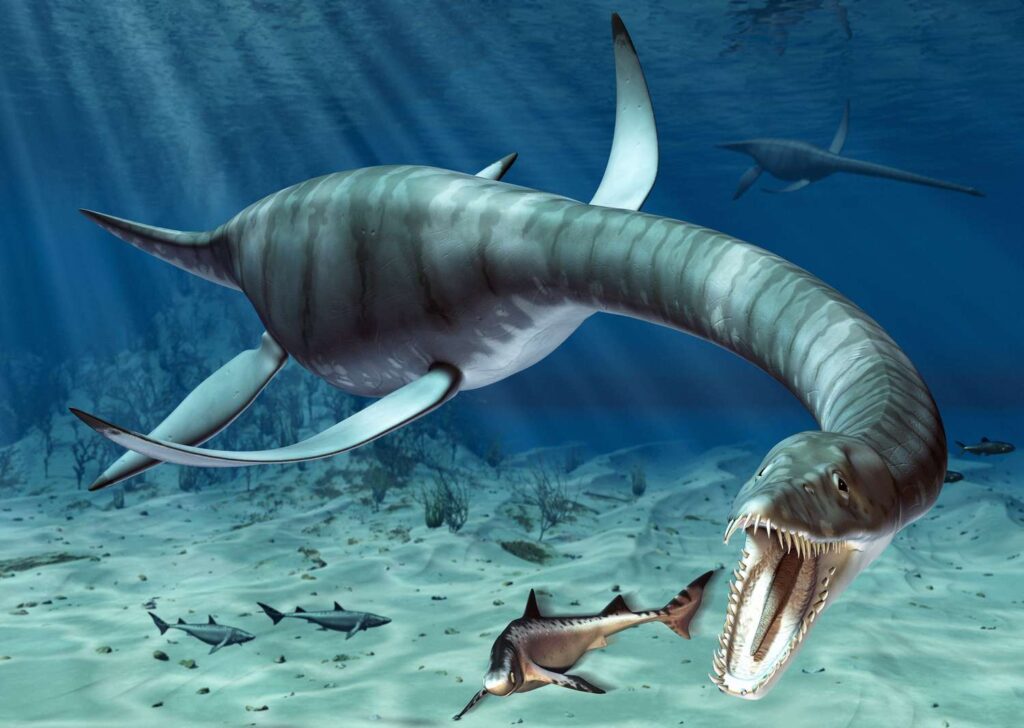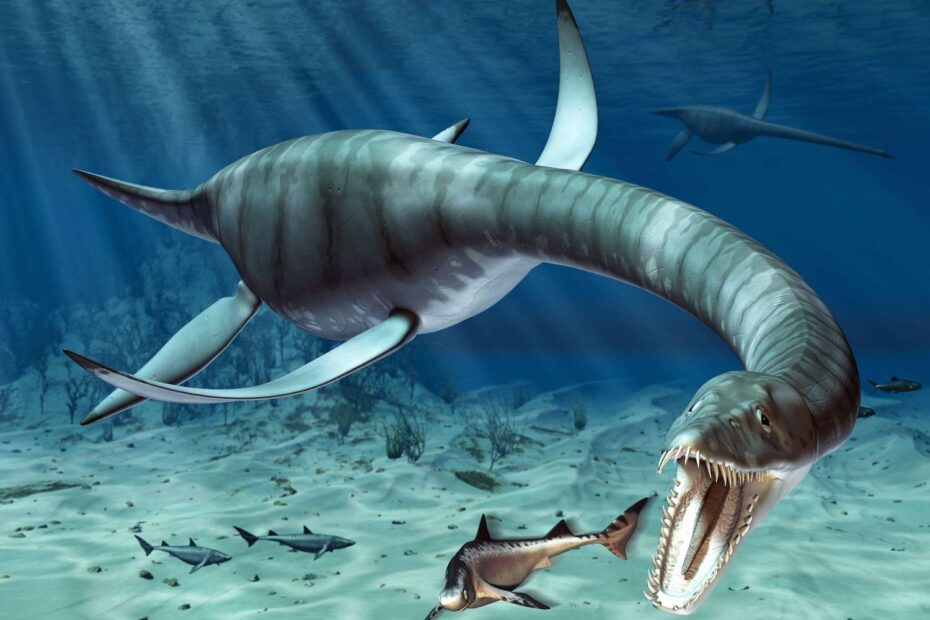The depths of the world’s oceans have always been shrouded in mystery, harboring a diverse array of life that has evolved and vanished over millions of years. Some of the most terrifying and awe-inspiring creatures to have ever roamed the seas are now long extinct, leaving behind a legacy of fear and fascination. In this exploration, we will delve into the eerie world of the 10 scariest extinct sea creatures that once ruled the ancient oceans.
1. Helicoprion: The Buzzsaw Jaw Terror
Our journey begins with the Helicoprion, a prehistoric shark that lived around 290 million years ago and is among scariest extinct sea creatures. What makes this creature truly terrifying is its bizarre spiral-toothed jaw, resembling a nightmarish buzzsaw. Found in the fossil record, the exact positioning of these teeth has puzzled scientists, adding an extra layer of mystery to this ancient predator.
Helicoprion is an extinct genus of shark-like fish that lived approximately 290 to 250 million years ago during the Permian and Triassic periods. What sets Helicoprion apart is its distinctive spiral tooth whorl, a unique dental structure that has puzzled scientists for decades. This unusual arrangement of teeth forms a circular saw-like structure, resembling a buzzsaw, located at the back of the fish’s lower jaw.
The exact function of the tooth whorl remains a subject of scientific debate. Some researchers propose that Helicoprion used its tooth whorl to capture and process prey, possibly slicing through the soft tissues of cephalopods and other marine organisms. Others suggest that the teeth played a role in feeding on smaller fish or acted as a defense mechanism.

Image Courtesy: https://www.geologyin.com/2020/11/helicoprion-spiral-mouthed-killer.html
Despite the mystery surrounding its feeding habits, Helicoprion was likely a formidable predator in the ancient oceans. Fossils of Helicoprion have been discovered in various parts of the world, shedding light on the diversity of life during the distant geological past. The study of Helicoprion contributes valuable insights into the evolution and adaptation of prehistoric marine lifeforms.
2. Megalodon: The Leviathan of the Deep
No discussion on scariest extinct sea creatures would be complete without mentioning the Megalodon. This colossal shark, which prowled the seas approximately 23 to 3.6 million years ago, is often considered the largest predator to have ever existed and was among scariest extinct sea creatures. With teeth measuring up to 7 inches in length, the Megalodon’s presence in the ancient oceans was undoubtedly a force to be reckoned with.
The Megalodon, meaning “big tooth,” was a colossal prehistoric shark that ruled the oceans roughly 23 to 3.6 million years ago, during the Cenozoic Era. Belonging to the family Otodontidae, this apex predator is considered one of the largest and most powerful predators to have ever existed. Fossilized teeth, some reaching over 7 inches in length, provide evidence of its awe-inspiring size.
Megalodons were estimated to grow up to 82 feet in length, dwarfing the modern great white shark. These marine giants had a global distribution, inhabiting warm coastal waters. With a set of massive, serrated teeth and a powerful jaw, Megalodons were adapted to feed on a variety of marine mammals, including whales and seals.

Image Courtesy: https://www.smithsonianmag.com/smart-news/megalodons-were-warm-blooded-and-it-was-a-blessing-and-a-curse-180982438/
Despite their incredible success as apex predators, Megalodons faced extinction around 3.6 million years ago. The exact cause of their demise remains uncertain, but factors such as changes in climate, competition for resources, and shifts in oceanic conditions may have contributed to the decline of this magnificent species. The Megalodon’s legacy lives on in popular culture, captivating the imagination through books, movies, and documentaries that explore the mysteries of its ancient existence.
3. Dunkleosteus: The Armored Menace
Venturing back to the Late Devonian period, approximately 358 million years ago, we encounter Dunkleosteus, a monstrous armored fish that instills fear even in the minds of modern marine enthusiasts. With a heavily plated exoskeleton and razor-sharp jaws, Dunkleosteus was a relentless predator, ruling the ancient seas with its unmatched ferocity and was among scariest extinct sea creatures.
Dunkleosteus, a prehistoric fish that roamed the oceans during the Late Devonian period, approximately 358 to 382 million years ago, was a formidable and fascinating creature. Belonging to the placoderm group, Dunkleosteus holds the distinction of being one of the largest and most fearsome predators of its time.
Named after David Dunkle, a former curator of vertebrate paleontology at the Cleveland Museum of Natural History, Dunkleosteus measured up to 33 feet (10 meters) in length and weighed several tons. Its most striking feature was its massive jaws, equipped with sharp, serrated bony plates instead of teeth. These plates, resembling shears, could generate an impressive biting force, estimated to be one of the strongest in the animal kingdom.
Dunkleosteus had a heavily armored exoskeleton, providing protection from predators and making it a dominant force in the Devonian seas. The armor consisted of thick bony plates covering its head and thorax, leaving only its jaw joint flexible for effective hunting. Despite its robust appearance, Dunkleosteus was surprisingly agile, using its streamlined body to navigate the waters and capture prey.
The diet of Dunkleosteus primarily consisted of other heavily armored fish and early jawed vertebrates. Its formidable jaws allowed it to bite through the tough armor of its prey, making it a fearsome apex predator of its ecosystem.

Image Courtesy: https://www.thoughtco.com/overview-of-dunkleosteus-1093659
The extinction event at the end of the Devonian period marked the decline of Dunkleosteus and many other marine species. The reasons for this mass extinction are not fully understood, but changes in climate and sea levels, as well as the evolution of new predators and competitors, likely played a role.
Today, Dunkleosteus remains a captivating subject of study for paleontologists, offering insights into the diverse and intriguing life forms that once inhabited Earth’s ancient oceans.
4. Liopleurodon: The Pliosaur Nightmare
Enter the Jurassic seas, where Liopleurodon, a massive pliosaur, reigned supreme. With a length estimated to be around 20 feet or more, this marine reptile was a true apex predator. Its powerful jaws, equipped with large, serrated teeth, allowed Liopleurodon to hunt and devour prey with unparalleled efficiency, making it one of the scariest extinct sea creatures.
Liopleurodon is an extinct genus of marine reptile that lived during the Middle Jurassic period, approximately 166 to 155 million years ago. Belonging to the group of reptiles known as Pliosaurs, Liopleurodon was a formidable predator with a streamlined body, powerful jaws, and large flippers adapted for an aquatic lifestyle.
One of the most distinctive features of Liopleurodon was its enormous size. Some estimates suggest that the largest individuals could reach lengths of up to 23 feet (7 meters) or even more. This made Liopleurodon one of the largest predators of its time, dominating the ancient seas with its impressive size and predatory prowess.
The most striking characteristic of Liopleurodon was its long and conical teeth, which were well-suited for catching and holding onto slippery prey like fish and squid. Its strong jaws and sharp teeth indicate that it was a formidable carnivore, likely preying on a variety of marine creatures in its ecosystem.
Despite its fearsome appearance, much of what we know about Liopleurodon comes from incomplete fossil remains, making it challenging for scientists to reconstruct its biology and behavior accurately. The genus is primarily known from fossilized teeth and fragments of jaw bones found in various locations across Europe.

Image Courtesy: https://www.amazon.in/Safari-Ltd-300529-Liopleurodon/dp/B00B3YM0WS
Liopleurodon’s portrayal in popular culture, notably in documentaries and films, often exaggerates its size and depicts it as an apex predator capable of taking down even the largest marine prey. However, due to the limited fossil evidence available, scientists continue to refine their understanding of this prehistoric marine reptile, piecing together the puzzle of its life and ecological role in the ancient oceans. Despite the mysteries that surround Liopleurodon, its place in the pantheon of prehistoric marine reptiles remains secure as one of the awe-inspiring giants of the Jurassic seas.
5. Tylosaurus: The Sea Serpent of the Cretaceous
Moving forward to the Late Cretaceous period, approximately 85 million years ago, we encounter Tylosaurus, a formidable mosasaur that patrolled the ancient seas. With its elongated body, powerful jaws, and a set of sharp teeth, Tylosaurus was a true sea serpent, capable of striking terror into the hearts of any creature unfortunate enough to cross its path.
Tylosaurus is a genus of large marine reptiles that lived during the Late Cretaceous period, approximately 87 to 82 million years ago. Belonging to the family Mosasauridae, Tylosaurus was a formidable predator and one of the largest mosasaurs, reaching lengths of up to 45 feet (14 meters) and was among scariest extinct sea creatures.
These prehistoric creatures were well-adapted to a fully aquatic lifestyle, with streamlined bodies, powerful tails, and paddle-like limbs that allowed them to navigate the oceans with agility. Tylosaurus had a long, conical snout filled with sharp, pointed teeth, indicating its role as an apex predator in the Late Cretaceous marine ecosystems.
One of the distinctive features of Tylosaurus was its elongated, barrel-shaped body, which contributed to its streamlined form. Its limbs had evolved into efficient paddles, emphasizing its adaptation to a life in the open ocean. As a reptile, Tylosaurus was also an air-breather, coming to the surface regularly to take in oxygen.
These marine reptiles were distributed across the Western Interior Seaway, a vast, shallow sea that divided North America during the Late Cretaceous. Fossil evidence suggests that Tylosaurus primarily preyed upon fish, cephalopods, and other marine creatures, using its powerful jaws and sharp teeth to capture and devour its prey.

Image Courtesy: http://www.prehistoric-wildlife.com/species/t/tylosaurus.html
The discovery of Tylosaurus fossils has provided valuable insights into the diversity of marine life during the Late Cretaceous period. The study of these fossils has helped paleontologists reconstruct the ancient marine ecosystems and understand the evolutionary adaptations that allowed mosasaurs like Tylosaurus to thrive as dominant predators in the prehistoric oceans.
6. Plesiosaurus: The Long-Necked Enigma
Another enigmatic creature from the Mesozoic era, the Plesiosaurus, deserves a spot among the scariest extinct sea creatures. With its long neck and formidable flippers, this marine reptile was a master of stealth and agility in the water. Its appearance likely struck fear into the hearts of smaller marine life, making it a top predator of its time.

Image Courtesy: https://www.thoughtco.com/plesiosaurus-1091520
7. Kronosaurus: The Marine Crocodile King
The Late Cretaceous period introduces us to Kronosaurus, a massive pliosaur with a crocodile-like head. Measuring up to 30 feet in length, this sea monster possessed a set of large, conical teeth designed for grasping and tearing apart its prey. Kronosaurus’s reign as a marine apex predator makes it one of the scariest creatures to have ever inhabited the ancient oceans.

Image Courtesy: https://www.dkfindout.com/us/dinosaurs-and-prehistoric-life/prehistoric-reptiles/kronosaurus/
8. Tanystropheus: The Bizarre Sea Serpent
Venturing into the Triassic period, we encounter Tanystropheus, a peculiar marine reptile distinguished by its incredibly long neck. With a neck that could reach up to three times the length of its body, Tanystropheus was a unique and intimidating sight in the prehistoric seas, likely using its neck to snatch prey with deadly precision.

Image Courtesy: https://www.ancient-origins.net/news-history-archaeology/tanystropheus-0015176
9. Orthoceras: The Ancient Squid Ancestor
Taking a step back to the Paleozoic era, around 443 million years ago, we encounter Orthoceras, an extinct cephalopod that resembles a straight-shelled squid. Despite its seemingly simple appearance, Orthoceras was a highly successful predator, using its streamlined shell and tentacles to navigate the ancient seas and capture prey with remarkable efficiency.

Image Courtesy: https://dinotoyblog.com/orthoceras-collecta/
10. Elasmosaurus: The Neck That Never Ends
Our exploration concludes with Elasmosaurus, a marine reptile from the Late Cretaceous period known for its extraordinarily long neck. With a neck comprising over half of its body length, Elasmosaurus was an agile hunter, capable of striking at prey with surprising speed and precision. The sheer length of its neck makes Elasmosaurus a haunting image among the diverse array of extinct sea creatures.

Image Courtesy: https://dinopedia.fandom.com/wiki/Elasmosaurus
The ancient seas were home to a myriad of terrifying and captivating creatures, each adapted to its environment in unique and awe-inspiring ways. From the spiral-toothed jaws of Helicoprion to the immense size of the Megalodon, these extinct sea creatures continue to captivate our imaginations, reminding us of the mysterious and often frightening nature of the oceans’ depths. While these creatures may be long gone, their fossilized remains serve as a testament to the ever-evolving and sometimes terrifying history of life on Earth.
Featured image courtesy: https://dinotoyblog.com/elasmosaurus-geoworld/
